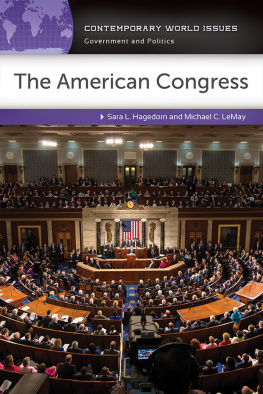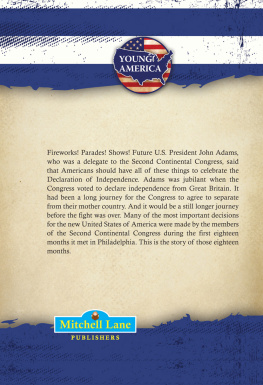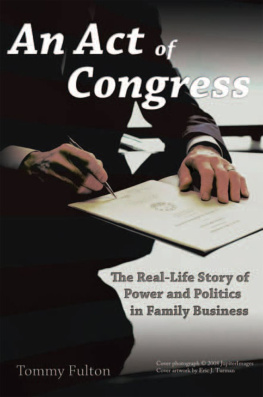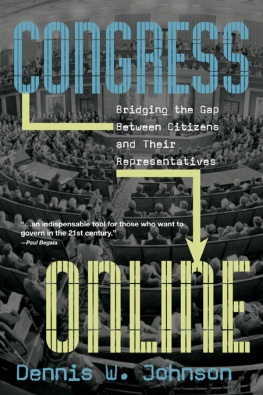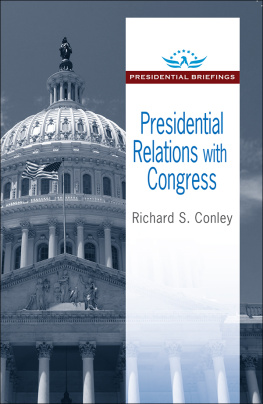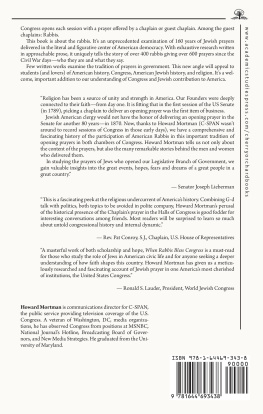The American Congress
Recent Titles in the
Contemporary World Issues
Series
STDs in the United States: A Reference Handbook
David E. Newton
Women in Sports: A Reference Handbook
Maylon Hanold
Robots: A Reference Handbook
David E. Newton
Homeland Security: A Reference Handbook
Michael C. LeMay
The Opioid Crisis: A Reference Handbook
David E. Newton
Abortion in the United States: A Reference Handbook, Second Edition
Dorothy E. McBride and Jennifer L. Keys
The Youth Unemployment Crisis: A Reference Handbook
Christine G. Villegas
Transgender: A Reference Handbook
Aaron Devor and Ardel Haefele-Thomas
Eating Disorders in America: A Reference Handbook
David E. Newton
Natural Disasters: A Reference Handbook
David E. Newton
Immigration Reform: A Reference Handbook
Michael C. LeMay
Vegetarianism and Veganism: A Reference Handbook
David E. Newton
Books in the Contemporary World Issues series address vital issues in todays society such as genetic engineering, pollution, and biodiversity. Written by professional writers, scholars, and nonacademic experts, these books are authoritative, clearly written, up-to-date, and objective. They provide a good starting point for research by high school and college students, scholars, and general readers as well as by legislators, businesspeople, activists, and others.
Each book, carefully organized and easy to use, contains an overview of the subject, a detailed chronology, biographical sketches, facts and data and/or documents and other primary source material, a forum of authoritative perspective essays, annotated lists of print and nonprint resources, and an index.
Readers of books in the Contemporary World Issues series will find the information they need in order to have a better understanding of the social, political, environmental, and economic issues facing the world today.
CONTEMPORARY WORLD ISSUES
The American Congress
A REFERENCE HANDBOOK
Sara L. Hagedorn and Michael C. LeMay

Copyright 2019 by ABC-CLIO, LLC
All rights reserved. No part of this publication may be reproduced, stored in a retrieval system, or transmitted, in any form or by any means, electronic, mechanical, photocopying, recording, or otherwise, except for the inclusion of brief quotations in a review, without prior permission in writing from the publisher.
Library of Congress Cataloging in Publication Control
Number: 2019941121
ISBN: 978-1-4408-6580-0 (print)
978-1-4408-6581-7 (ebook)
232221201912345
This book is also available as an eBook.
ABC-CLIO
An Imprint of ABC-CLIO, LLC
ABC-CLIO, LLC
147 Castilian Drive
Santa Barbara, California 93117
www.abc-clio.com
This book is printed on acid-free paper 
Manufactured in the United States of America
Contents
The United States of America is the oldest democratic form of government operating under the authority of a single documenta constitution. The American Congress: A Reference Handbook discusses the first branch of the American governmentthe American Congress. The founding fathers of the United States created a new republican form of government that was intended to establish a more powerful and effective government than the one that had been established under the Articles of Confederation. But the founders also distrusted the idea of a central government that could become too powerful or too prone to abuse that power. As this institutional analysis demonstrates, their solution was an elaborate system of governmental powers that entailed two fundamental principles with respect to governmental power and authority that were ingeniously designed to achieve those two goals: the separation of power into three branches of government and a system of checks and balances incorporated into the separate branches of government intended to limit government by so structuring power that each branch had some constitutionally prescribed powers to offset or check and balance the powers of the other two branches.
Article I of the U.S. Constitution, adopted in 1789, details the authority, concept, powers, and bicameral structure of the legislative branch of the new republican form of the U.S. government. From the founding of the constitutional government until World War I, the American Congress was the more powerful of the three branches, and Article I is the longest and most elaborately detailed of the Articles, each of which establishes a separate branch of the national government as part of a federal union designed to delegate some power to the national level but to reserve power not otherwise specified to the state governments. As this book makes clear, the Constitution purposively allowed for the evolution of the national government to adapt to a changing world. The document, and the government it established, has served the nation admirably for more than two hundred years.
The basic form of government and the structuring of political power and authority depend not only on the constitutional base but also on those who occupy the offices of the branches of government as, over time, they give life and meaning to the words enshrined in the founding document. How the Congress evolved over two hundred years is one of the more fascinating aspects of American political history. Congress had to confront innumerable problems over those two hundred years. How those problems were faced raised issues, both legal and political, as solutions were sought. Prior to World War I, Congress had the upper hand because all laws to govern the nation had to be passed in identical language by both chambers of Congress. It had the power of the purse. It had oversight power over the executive branch. It had design authority over the federal judiciary and approved nominees to the federal courts. In the eighteenth and nineteenth centuries, the United States was not yet a major world power, and the president, as commander in chief, was not the dominant role-player. Most occupants of the office viewed the role of the president as simply seeing that the laws passed by Congress were faithfully executed. Presidents did not control or set the legislative agenda. Congress had the sole power to declare war, and presidents generally deferred to Congress in decisions to engage the military in foreign entanglements. So too, the power of judicial review had to be asserted and established in Marbury v. Madison (5 U.S. 1, 1803).
The American Congress shows how Congress, as an institution, evolved over time: in its own powers, in its relationships with the other two branches, in its internal practices and procedures, and in its influence over American politics and society. The book, aimed at the general reader and undergraduate college and university students, follows the format of all volumes in the Contemporary World Issues series.
discusses the history and background of congressional politics. It covers who became the major stakeholders in congressional politics. It examines the internal structure and procedures of the U.S. House of Representatives and of the U.S. Senate and how they changed over time. The historical background chapter is designed to provide the context through which the reader can better understand current events and problems and issues that Congress faces. It presents that discussion in a comprehensive and unbiased manner, allowing readers to form their own judgment on the issues.

